The United States is facing an unprecedented demand for nursing professionals, driven by demographic shifts, evolving healthcare needs, and persistent challenges within the system. As we navigate 2023, the urgency for nurses is not only persistent but escalating, underscoring their crucial role in safeguarding the nation’s health. This article explores the current trends, challenges, and potential solutions surrounding the growing demand for nurses in the USA, drawing insights from reputable sources in the healthcare industry.

Aging Population and Healthcare Demands
The surge in demand for nursing professionals is primarily fueled by the aging population, with the baby boomer generation entering retirement. There is an increased need for healthcare services, especially those addressing chronic and age-related conditions. Nurses play a pivotal role in delivering specialized care, managing complex health issues, and promoting overall well-being among the elderly.
– American Association of Colleges of Nursing (AACN). (2022) https://www.aacnnursing.org/News-Information/Fact-Sheets/Nursing-Shortage
Diversification of Nursing Roles
Nursing roles have expanded beyond traditional settings, encompassing community health initiatives, home healthcare services, and preventive care programs. This shift recognizes the valuable contributions nurses make to public health, emphasizing the need for a versatile and adept nursing workforce.
– Bureau of Labor Statistics. (2022). https://www.bls.gov/ooh/healthcare/registered-nurses.htm
Persistent Staffing Shortages and Retention Struggles
Despite the growing demand, staffing shortages persist across healthcare institutions. High turnover rates and challenges in retaining seasoned nursing professionals contribute to the shortage. Addressing these challenges requires a comprehensive approach, including competitive compensation packages, enhanced workplace support, and initiatives fostering professional growth and job satisfaction.
– HealthLeaders. (2022). https://www.healthleadersmedia.com/nursing/strategies-nurse-retention
Constraints in Nursing Education Capacity
The limited capacity of nursing education programs to produce enough qualified professionals is a significant challenge. Resource constraints, faculty shortages, and infrastructure limitations impede the ability to train a sufficient number of nurses. To overcome this bottleneck, investment in nursing education, expansion of programs, and innovative training approaches are crucial.
– National League for Nursing. (2022). http://www.nln.org/nlnjournal/index
Technology Integration and Healthcare Advancements
Advancements in healthcare technology, such as telehealth, digital health records, and intelligent healthcare systems, are reshaping nursing care delivery. Embracing and adapting to these innovations not only enhance efficiency but also attract tech-savvy individuals to the nursing profession.
– Healthcare Information and Management Systems Society (HIMSS). (2022). (https://www.himss.org/resources/nursing-informatics)
Conclusion
The demand for nurses in the USA is at a critical juncture, shaped by demographic shifts, healthcare dynamics, and the evolving role of nursing professionals. Addressing these demands requires a comprehensive strategy, encompassing investments in education, retention initiatives, and recognition of nurses’ diverse contributions. A resilient and well-supported nursing workforce is indispensable for meeting the dynamic healthcare needs of the nation as the landscape continues to evolve.
